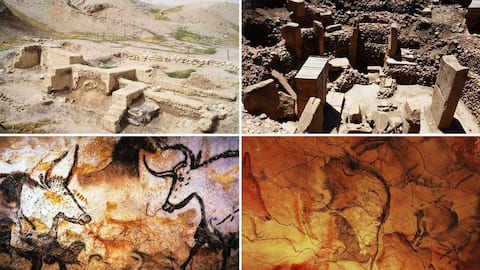Exploring the most ancient prehistoric sites in the world
What's the story
The allure of prehistoric sites lies in their ability to connect us with the earliest chapters of human history. Across the globe, these sites not only mark the existence of ancient civilizations but also provide critical insights into human evolution, art, and the development of societies. Let's discover five prehistoric sites, from rock shelters adorned with prehistoric paintings to monumental stone structures.
Paleolithic cave art
Bhimbetka Caves, India
The Bhimbetka rock shelters in central India, spanning the Paleolithic and Mesolithic periods, are a UNESCO World Heritage Site. Featuring over 700 adorned rock shelters with prehistoric paintings dating back over 30,000 years, they depict daily life, wildlife, rituals, and abstract patterns, providing insights into ancient cultures. Preserved by the Archaeological Survey of India, Bhimbetka offers a glimpse into humanity's artistic and cultural evolution.
Neolithic revolution
Göbekli Tepe, Turkey
Dating back to the 10th millennium BCE, Göbekli Tepe in southeastern Turkey predates Stonehenge by 6,000 years. Known for its massive carved stones and complex temples, it features early ritual architecture. Intricate animal and symbolic carvings suggest it was a significant ceremonial site, revolutionizing our understanding of the Neolithic revolution by suggesting that religious practices possibly spurred agricultural development.
Paleolithic paintings
Lascaux Caves, France
The Lascaux Caves contain Paleolithic cave paintings up to 20,000 years old, depicting regional fauna from the Upper Paleolithic period. Their artistic sophistication suggests a deep understanding of art and nature. Closed to the public in 1963 to prevent damage, replicas are available for viewing. These caves still captivate archaeologists and art historians with their exquisite depictions and insights into prehistoric life.
Megalithic structure
Stonehenge, England
Stonehenge, the iconic prehistoric monument in England, is steeped in mystery. Constructed between 3000 BCE and 2000 BCE, it features massive standing stones within a complex of Neolithic and Bronze Age structures. Its purpose sparks lively debate, ranging from astronomical observatory to religious site. Alignment with solstices and equinoxes showcases the inhabitants' advanced understanding of astronomy, adding to the allure of this ancient wonder.
Paleolithic artwork
Altamira Cave, Spain
Dubbed the "Sistine Chapel of Paleolithic Art," Altamira Cave in northern Spain boasts exceptional Upper Paleolithic artwork dating back 36,000 years. Its ceiling features vivid paintings of bison, deer, and horses, initially doubted for their realism. Discovered in the late 19th century, Altamira's art has been pivotal in understanding prehistoric human culture, shedding light on early Homo sapiens' artistic expression and technological prowess.
Neolithic site
Çatalhöyük, Turkey
Dating back to around 7500 BCE, Çatalhöyük in Turkey is among the world's best-preserved Neolithic sites, offering a glimpse into early urban life. Its closely built dwellings, accessed via rooftops, reflect a communal society focused on security and cooperation. Intricate murals and reliefs adorning the walls, reveal complex spiritual beliefs and social structures of one of the earliest urban societies.
